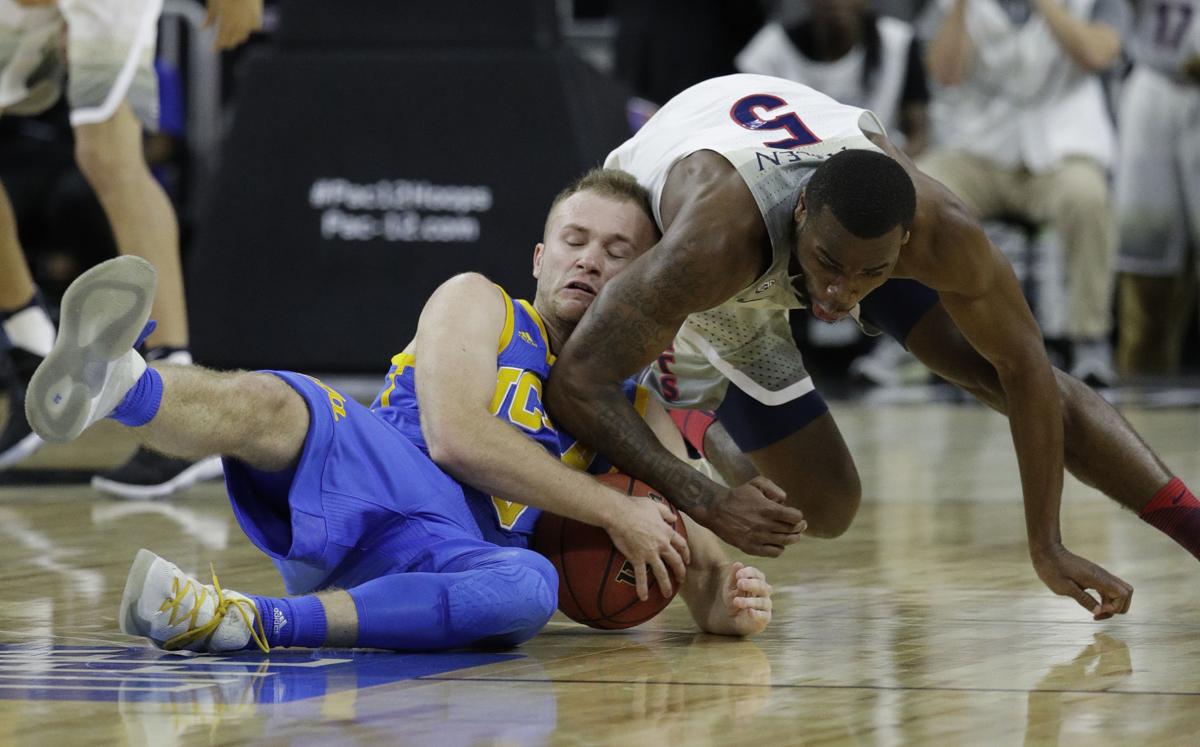LAS VEGAS —
The difference between the basketball teams of UCLA and Arizona is so slight that there’s no such thing as an upsetter and an upsettee.
You lose, you’re upset. You win, you get amnesia in a hurry because the Oregon Ducks are waiting in Saturday’s Pac-12 Tournament championship game.
If Lauri Markkanen is a beast, you’re a beauty. If Bryce Alford can’t buy a bucket, if he shoots 2-for-12, it’s like someone shoves a basketball down your windpipe.
On Friday, Arizona was both a beauty and a beast. Arizona won 86-75, the rubber game of a three-game series, but you get the feeling if UCLA and Arizona meet in the Final Four, it’ll be a toss-up.
The uncertainty Friday was such that two pilots and an airplane were on standby at the Las Vegas airport in the wee hours of Saturday morning, assigned to fly the Wildcats to Tucson. Just in case.
The Wildcats were scheduled to get home while those working the late shift at T-Mobile Arena were still mopping up.
Instead, Arizona’s traveling party returned to a hotel on the Vegas strip and put a do-not-disturb sign on the door.
Sweet dreams, for sure.
In the final moments before Friday’s tip-off, the PA announcer at T-Mobile chattered incessantly, encouraging the crowd to make some noise so as to impress the an ESPN audience.
Noise? It was 11:51 p.m. on the East Coast. Shouldn’t he have said “try to hold it down?”
Such is the predicament of Pac-12 basketball. Friday’s tip time was the latest for any Arizona game dating to a 10:05 p.m. (Tucson time) start at Washington State, March 1995, a game that almost predictably went into double-overtime, with Arizona winning 114-111.
It didn’t matter because Arizona won. Any time is a good time when you win, especially in March.
The top third of the Pac-12 is so appealingly good this season that even the hoops seismologists on the East Coast are paying attention. Oregon, UCLA and Arizona have disrupted sleep patterns from Maine to Miami.
Unfortunately, most would-be viewers simply hit he sack and don’t know the difference between Allonzo and Lonzo – Arizona’s Trier and UCLA’s Ball.
On Thursday, Pac-12 commissioner Larry Scott, whose contract was extended through 2022 last week, suggested he created, and is responsible for, the basketball excellence at the top of the league.
Here’s what he said: “The improvement of Pac-12 men’s basketball that we’re witnessing this week starts with the new television contracts that we entered into, which required us to be more flexible in terms of when we would play, Wednesdays and Thursdays rather than just Thursdays. Doubleheaders, 6 p.m. games as well as 8:30, 8:00, 8:30 games, approximately, in order to get on ESPN, and we now have over 60 games on ESPN, and in order to get every game telecast on the Pac-12 Networks.”
Well, probably not.
The old Pac-10 was just as good from 1988-2008 as it is now and many times, especially at Arizona and Stanford, it was better.
Is there better visibility when games tip off at midnight in the East, and when so many bottom-feeding games are broadcast on the obscure Pac-12 Network?
Probably not. It’s a stretch to imagine a 5-star recruit from New York staying awake until 2 a.m., to watch the Pac-12 Tournament, or any Pac-12 game.
During the second half of Friday’s Arizona-UCLA game, I counted 52 of the 100 uber-expensive court-side seats empty. The Pac-12 said the game was sold out. If so, more than half of those six-figures-for-the-week seats were presumably vacated by those who cut out early for some shut-eye.
But that’s the cost of becoming partners with ESPN (and to a lesser extent, Fox) which pays ridiculous media rights fees to fill their late-night programming slots with UCLA and Arizona games.
When the Bruins and Wildcats met at McKale Center on Feb. 25, when tipoff was a more sensible 6:15 p.m. Tucson time, it drew 2.2 million viewers. It’s likely Friday’s audience was half that, struggling to reach 1 million.
But the money still spends the same.
The commissioner’s best move has been just that — a move. When the league vacated Los Angeles’ Staples Center and moved first to Las Vegas’ MGM Grand and now to T-Mobile, it became the place to be.
It’s booze and basketball. It has been a remarkably good time for those in the seats, those who spend hundreds and hundreds of dollars on The Strip, and it has been even better for the casinos and all who sell beer for $13 a bottle.
No one has enjoyed the move to Las Vegas more than Arizona fans, who continue to buy most of the seats (and the beer). Of the 19,224 at Friday’s game, about 12,000 were Wildcat fans.
No one’s going to ask for their money back.





